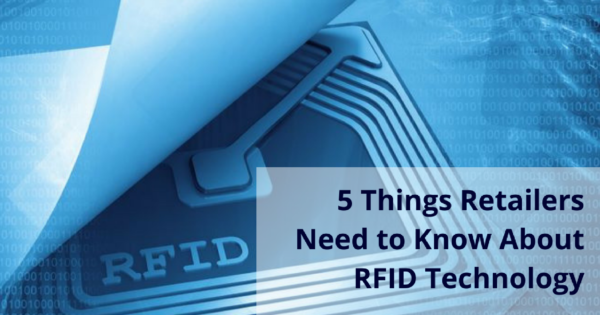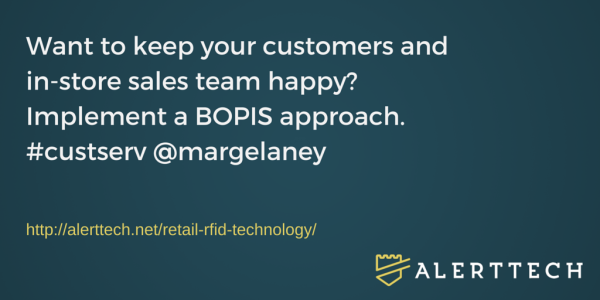What if you could decrease your online order cancelations by 60%? That’s exactly what one children’s clothing retailer was able to do using radio-frequency identification (RFID) technology to reduce online out-of-stocks.
However, RFID goes beyond reducing online out-of-stocks. It provides an all-encompassing improvement to inventory accuracy, sales, margins, and expedited returns, according to a research study at Auburn University.
It’s these kinds of RFID benefits that have retailers giving this technology a much closer look.
[xyz-ihs snippet=”TOFU2-Retail-Technology-button”]
Why RFID in Retail?
Why is RFID technology becoming so popular for retail stores? Is it because it’s the cool new thing to do in the retail world? Or are there tangible benefits?
RFID technology goes beyond the basic self-checkout lines. Now, as it continues to develop, RFID is being used to increase work efficiency and boost sales, job satisfaction, and customer service levels.
Innovative retailer, Zara, has built their business around RFID. They are now able to conduct a physical inventory in their outlets in about 15% of the time it used to take.
Before you run out to plan a few RFID pilot projects for your stores, there are five things you need to know about RFID.
1) BOPIS is a Win-Win
Perhaps one of the biggest benefits in RFID technology is the buy-online, pick-up-in-store (BOPIS) advantage.
As a retailer, managing inventory isn’t always easy. Through technology, you’re able to be on the grounds of each of your stores to see what’s in stock and what’s available for purchase. When your customer goes to your store (and remember, it’s all about your customer), she will find that what you said was in stock was actually in stock.
BOPIS technology gives your customer peace of mind. She knows what she wants is waiting for her at your store, and she knows it’s waiting for her right when she walks in. It’s one of the easiest and most effective ways to keep your customers and your in-store sales team happy.
2) RFID Technology Provides a Faster Checkout Experience
Okay, faster checkouts might not sound all that sexy, but when you look at it from the customer’s standpoint, it is.
Consumers today demand high levels of service. As your customer stands in line waiting to give you her money, she grows exponentially impatient with each minute she has to wait.
With RFID technology, the impatience melts away. Instead, she’s left delighted by her buying experience – something you can bet she’ll remember the next time she needs to make another purchase from you or your competitors.
3) Retail RFID Technology is Being Adopted Faster Than Ever Before
Over half of product manufacturers have implemented item-level RFID. Another 21.1% plan to implement RFID over the next year and 18.4% say they plan to implement RFID over the next two years. That’s according to the 2014 GS1 US Standards Usage Survey.
The retail industry has reached the tipping point. Now, an increasing number of retailers have seen the proven concept and are adopting RFID technology. As more retailers see tangible results, other retailers jump on board.
4) There’s a Significant Cost to Adding RFID Technology
According to a 2009 RFID Journal report, retailers were spending an average of $30,000 for a single store pilot. That cost has decreased over the last 6 years. Now, there’s a new cost standing in the way of retailers adopting this technology: employee acceptance.
As a retailer, you work hard to optimize your stores and maximize your daily routines. Adding in new technology shakes up your work and forces your employees to get uncomfortable while learning something new.
It’s the sales floor level changes that pose the greatest obstacle for retailers. Employees are curious about new technology, but inevitably their excitement boomerangs back to one question: “What’s in it for me to make my job easier?”
Your team wants to know how RFID technology will make their jobs easier. At the corporate level, it’s easy to see the big picture and how this technology will improve operations once implemented. At the store-level, it’s harder to see until the technology is put into effect.
To overcome this challenge, you must show your team how job satisfaction will improve through fewer frustrated customers and more efficient store management during busy times.
5) Your Retail Store Must Calculate the ROI of RFID Technology
Before you make any major investment in your retail operations, you need to know it’s worth your time.
There are tools to help you see your return on this investment before you buy. For example, if you are in the fashion industry, check out the RFID Journal’s Fashion Retail ROI Calculator to gauge what you can expect to see in dollars and cents.
These calculators base ROI on in-store deployments, but there are ROI accrual benefits away from the store too, according to some German retailers. By implementing RFID technology throughout the supply chain, you could see time savings and greater accuracy in factory picked orders.
The ROI of RFID depends on your labor costs and the value of real-time data accuracy. – Tom Watson, AMITracks
Through better inventory accuracy, you’re able to optimize reorder cycles, reduce out-of-stocks, and improve your multi-channel capabilities, just to name a few.
[xyz-ihs snippet=”TOFU2-Retail-Technology-button”]
Will You Adopt RFID Technology?
[Tweet “5 Things Retailers Need to Know About RFID Technology #retail @margelaney”]
Through improved inventory accuracy and streamlined sales processes, RFID technology should allow your store to better serve your customers online, on-the-go, and in-store. It’s a win for your customers, a win for your employees, and an even bigger win for your bottom line. If you need to learn what analytics to track in order to calculate the ROI of an RFID implementation, check out our whitepaper, “In-store Apparel Retail Analytics”.
[xyz-ihs snippet=”TOFU2-Retail-Analytics”]

